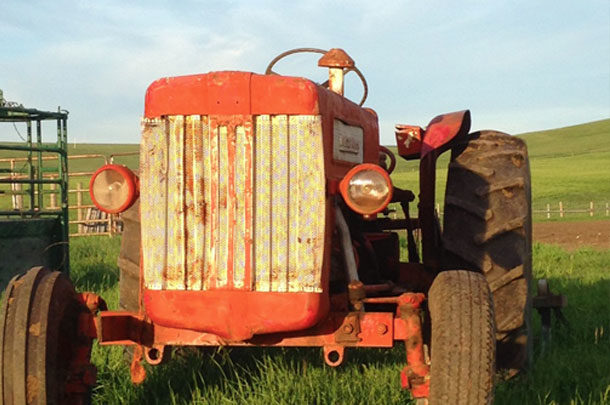Which is where the trouble starts.
It shouldn't be that hard to fire up a tractor. Just turn a key and vroom! But every tractor on our place is a special flower. Both loaders fire up with the turn of a key, unless someone forgot to plug in the block heater in any month other than July and August. Occasionally June, if we're having an unseasonably warm spring.
The older loader has a port below the steering wheel to inject starter fluid. In the newer model, designers decided it would be easier to crawl over the front tire and reach up under the hood at an anatomically impossible angle to spray fluid into some orifice you can't actually see. No, not that one. But no worries. You'll know you got it right if it doesn’t explode when you turn the key.
Starting the old Case requires turning on the key then pushing an ignition button. This makes no sense to me, but I've also never comprehended why, on so many tractors, turning off the key does nothing. You must pull out a kill knob to make the engine stop. Two mechanisms to do what diesel pickups have accomplished with one key for more than half a century. Are tractor engines that different? Or do the manufacturers simply cater to grown-up versions of my 10-year-old, who loves to push buttons and pull levers – the more the better?
The big, four-wheel drive Versatile – well, I'm not allowed to touch that since it's always hooked to complicated things like the air seeder, where pulling the wrong lever can result in dire consequences. I am relegated to the ancient, wheel-driven hay rake. Not much I can screw up there, unless I turn too sharply to the right and the rake climbs the rear tractor tire and flops over on its back, tines quivering like a big metal bug.
Or I get the rock picker, on which I must lift and lower the picker bar, turn the roller off and on, and dump the hopper. Even by accident, at least one-third of the time I should pull the proper lever at the proper time. But hey, that's me; I live to defy the odds.
Then there's the 1950s era International we use to work the roping arena. Despite being a basic four-cylinder gas engine, this starting process is the most complicated.
First, one must lay hands upon the hood and recite a suitable blessing. Burning a sprig of sweetgrass and performing a brief smudging ceremony isn't unheard of, though I have yet to see conclusive evidence that the Great Spirit and the tractor gods share office space. Spiritual considerations satisfied, grab the old saddle blanket off the shredded foam seat and shake out any resident mice and their droppings. (I recommend doing this at arm's length while holding your breath.) Replace the seat cover and climb aboard to brace both feet and pull with all your might in hopes of budging the choke knob, then pull the throttle lever down exactly one-third of the way.
You may now attempt to start the tractor.
On good days, when you turn the key, the engine responds with a slow, painful grind. Bad days involve jumper cables. Allow the engine to turn over exactly seven times. Eight will flood it, and you'll have to come back in an hour and begin again at the beginning, including extra blessings to cleanse the swear words from the air.
Turn the key off and count to sixty. As long as you're just sitting there, it couldn't hurt to toss in another prayer. Or you can give the choke knob a few more tugs, for all the good it will do. Finally, turn the key again. Nine out of 10 times the tractor will gasp, sputter and roar to life. And on the 10th day ... well, we probably should be working instead of roping, anyway.
It has now been an hour since I left the house. The tractor is running, but I can't perform any actual work until I attach a piece of equipment, which will require climbing on and off the tractor 37 times to deal with jacks and hitches and pins, each of them with a secret trick to it. And once that’s done. ...
Well, this is a family publication, so let’s skip my opinion of hydraulic hose connections. FG
Kari Lynn Dell is a third-generation cowgirl, horse trainer and rodeo competitor. She writes from her family ranch on the Montana Blackfeet Reservation. Read more of her scribblings, novels and short stories on the northern frontier here.
PHOTO: To start a tractor, one must first lay hands upon the hood and recite a suitable blessing. Photo provided by Kari Lynn Dell.











